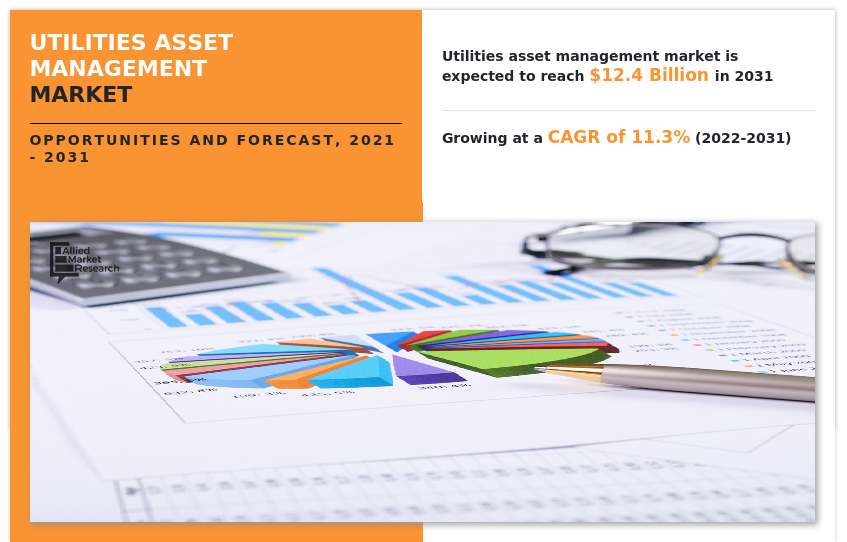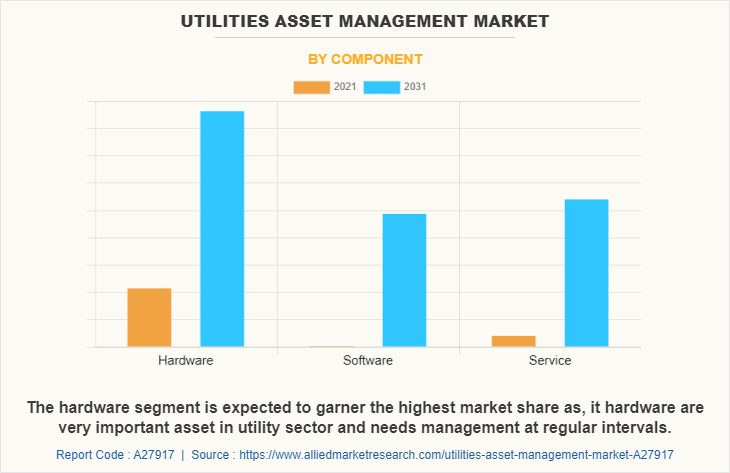Utilities Asset Management Market Research, 2031
The global utilities asset management market size was valued at $4.3 billion in 2021, and is projected to reach $12.4 billion by 2031, growing at a CAGR of 11.3% from 2022 to 2031.
Robust utility asset management ensures environmental, health, and safety standards, superior service quality, and improved safety for personnel and equipment. Rise in energy demand, aging infrastructure, increase in distributed energy resources, and need for efficient and reliable energy drive the utility asset management market. Moreover, adoption of IoT and AI technology in utility asset management for better insights create lucrative opportunities for the global market growth. However, lack of skilled workforce and high cost of implementation of asset management in the utilities sector hampers the Utilities Asset Management Market Growth.

Utility asset management combines technical concepts with thorough economic analysis to provide a cost-effective and efficient approach to operating, maintaining, and renewing electrical assets. Moreover, energy providers are looking to lower electricity bills of consumers and ensure new technologies for better efficiency. The utilities asset management market is segmented into Component, Utility Type and Application.
The Utility asset management market is segmented on the basis of component, utility type, application, and region. On the basis of component, the market is segmented into hardware, software, and service. The hardware segment is further divided into sensors, cameras, and others. The software segment is further divided into on-premise and cloud. The service segment is further divided into professional services and managed services.
Furthermore, the professional services segment is further categorized into training & education, integration & deployment, and support & maintenance. By utility type, the market is fragmented into public utility and private utility. Depending on application, it is segregated into transmission & distribution lines, sub-station, and others. Region wise, it is analyzed across North America, Europe, Asia-Pacific, and LAMEA.
The key players that operate in the Utilities Asset Management Industry are ABB Ltd., Black & Veatch., Cniguard Ltd., DNV GL, Enetics, Inc., EnrichAI, IBM Corporation, IFS, InPipe Energy, Microsoft Corporation, Netcontrol Oy, Neuroflux, Oracle corporation, Platoi, Schneider Electric, Siemens AG, and Vigti. These players have adopted various strategies to increase their market penetration and strengthen their position in the Utilities Asset Management Industry.
By component, the hardware segment dominated growth of the Utilities Asset Management Market Share in 2021, and is expected to maintain its dominance in the upcoming years, owing to rapid expansion of power generation facilities. However, the software segment is expected to witness highest growth the forecast period, owing to high need of asset management software for smooth operations and efficiency.

North America dominates the utility asset management industry. Growth of the market in this region is attributed to several factors such as increase in digitalization and adoption of IoT sensors by the utility sector. Moreover, presence of key players is providing ample growth opportunities for the market growth. However, Asia-Pacific is expected to witness highest growth rate during the forecast period, owing to rapid expansion of energy infrastructure across the region.
[REGIONGRAPH
Top Impacting Factors
Increase in energy demand
Constant increase in energy consumption, owing to rapid urbanization and increase in population has led to a massive increase in energy demand. This has generated a need for new solutions and specific processes that are capable of increasing production from same resources. As investments in smart grids increase, asset and energy management solutions extract more value from system and efficiently handle growing demand. Hence, increase in energy demand drives adoption of asset management in energy and utilities sectors. For instance, according to the International Energy Agency, during 2022–2024, there will be growth of 2.7% for electricity worldwide.
Adoption of advanced technologies such as IoT
IoT, with its web of interconnected devices, is revolutionizing the way public engages, lives, and works. From wearables and inventory managements and connected machines, IoT can provide tangible benefits everywhere. IoT can help to automate and streamline tedious, repetitive tasks such as delegation, scheduling, and reporting. Utility companies spend a great deal of time, money, and effort on regular inspections to prevent errors and failures.
However, if the utility asset is IoT enabled, most of these inspections can be avoided and information can be reported on the condition of the asset prior to shut down. Hence, IoT can save a lot of maintenance costs that are currently spent on regular inspections and outdated infrastructure. Thus, IoT is gaining high traction across the utility sector, which is expected to offer remunerative opportunities for expansion of the utility asset management market.
COVID-19 Impact Analysis
The outbreak of the COVID-19 pandemic has hit many industries, and utility asset management is no exception. Electricity demand is down, owing to complete closure of large trading houses, processing plants, and manufacturing industries. This has led to slight downfall in the utility asset management industry during COVID-19. For instance, according to the U.S. Energy Information Administration (EIA), power sales in the commercial sector dropped by 4.7% in 2020 as many businesses remained shut, owing to COVID-19. However, the market is expected to grow rapidly after the pandemic, owing to rise in adoption of remote working and automation of process in the utility sector across the globe.
Key Benefits For Stakeholders
- This report provides a quantitative analysis of the Utilities Asset Management Market Forecast, current trends, estimations, and dynamics of the utilities asset management market analysis from 2021 to 2031 to identify the prevailing utilities asset management market opportunities.
- The market research is offered along with information related to key drivers, restraints, and opportunities.
- Porter's five forces analysis highlights the potency of buyers and suppliers to enable stakeholders make profit-oriented business decisions and strengthen their supplier-buyer network.
- In-depth analysis of the utilities asset management market segmentation assists to determine the prevailing market opportunities.
- Major countries in each region are mapped according to their revenue contribution to the global market.
- Market player positioning facilitates benchmarking and provides a clear understanding of the present position of the market players.
- The report includes the analysis of the regional as well as global utilities asset management market trends, key players, market segments, application areas, and market growth strategies.
Utilities Asset Management Market Report Highlights
| Aspects | Details |
| By Component |
|
| By Utility Type |
|
| By Application |
|
| By Region |
|
| Key Market Players | S&C Electric |
Analyst Review
In accordance with insights by CXOs of leading companies, the global utility asset management market is projected to witness prominent growth, especially in Asia-Pacific and North America. This growth is attributed to increased investments by private utilities and public utilities providers for automation and adoption of IoT asset management solutions. In addition, adoption of IoT-based devices globally provides ample growth opportunities for utility asset management solutions.
The current business scenario has witnessed increase in adoption of utility asset management solutions in developed as well as developing regions as asset management software in utilities maximizes business efficiency by minimizing operational efforts with faster processing times and lower labor costs, enhancing its adoption in the utility asset management market.
Moreover, utility businesses are becoming more inclined toward use of asset management technology to increase revenue, reduce costs, improve efficiency, and provide workers with a better experience. Many things have become easier and better, owing to adoption of utility asset management. Utility asset management has helped the energy sector to make better decisions, collect and analyze data, and automate workflows. Moreover, adoption of IoT in asset management has become even more vital, owing to ageing infrastructure and ever-evolving corporate environments. Moreover, enterprises make significant investments in R&D to enhance their existing solutions and deliver new solutions as well as automation technologies. For instance, in April 2019, DNV GL launched the 9th Edition of ISRS. ISRS9 or 9th edition, offers the management system to deal with increasingly more important aspects of asset management, energy management, information security, knowledge management, and social responsibility.
Prominent market players are exploring new technologies and platforms to meet increase in customer demands. Product launches, partnerships, and acquisitions are expected to enable them to expand their product portfolios and penetrate different regions. For instance, in May 2022, Black & Veatch & The American Society of Mechanical Engineers (ASME) launched Twinify Technologies LLC. Twinify’s digital twin solutions are used for improving infrastructure asset efficiency and responsiveness and reducing downtime.
Robust utility asset management ensures environmental, health, and safety standards, superior service quality, and improved safety for personnel and equipment. Rise in energy demand, aging infrastructure, increase in distributed energy resources, and need for efficient and reliable energy drive the utility asset management market.
North America dominates the utility asset management industry. Growth of the market in this region is attributed to several factors such as increase in digitalization and adoption of IoT sensors by the utility sector. Moreover, presence of key players is providing ample growth opportunities for the market growth.
The global utilities asset management market size was valued at $4,275.18 million in 2021, and is projected to reach $12,436.52 million by 2031, registering a CAGR of 11.3% from 2022 to 2031.
The key players that operate in the utility asset management market are ABB Ltd., Black & Veatch., Cniguard Ltd., DNV GL, Enetics, Inc., EnrichAI, IBM Corporation, IFS, InPipe Energy, Microsoft Corporation, Netcontrol Oy, Neuroflux, Oracle corporation, Platoi, Schneider Electric, Siemens AG, and Vigti. These players have adopted various strategies to increase their market penetration and strengthen their position in the industry.
Loading Table Of Content...



